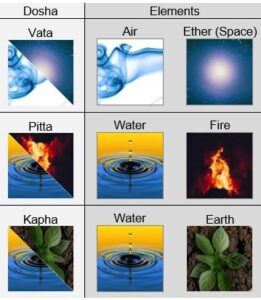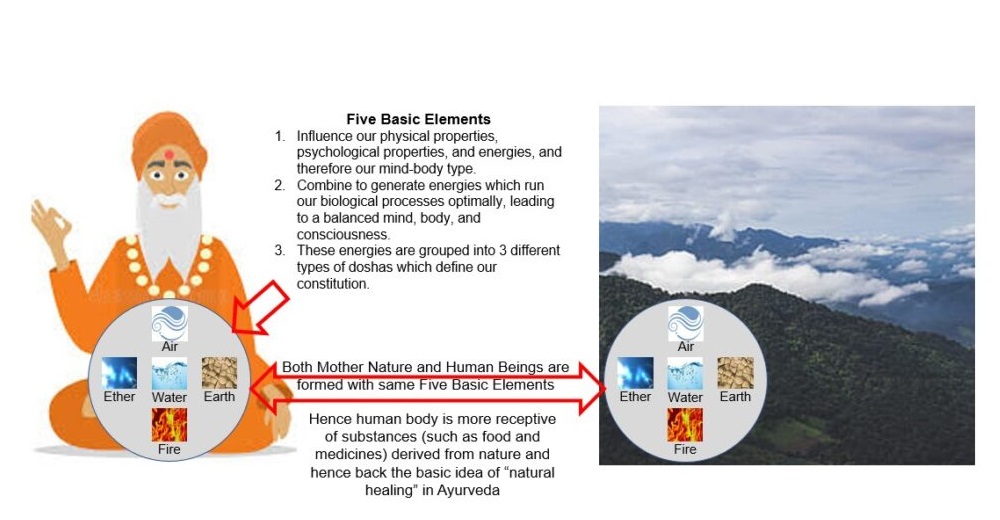Making sense of Five Basic Elements, Doshas, Gunas, and Five Senses
In the blog Why are each of us unique? we understood that human beings are composed of the five basic elements (henceforth referred to as simply elements), which in turn determine their “constitution.” We deliberately kept that blog simple.
In this blog, we shall further discuss the concepts of five basic elements and Tridosha.
Five basic elements
According to Ayurveda, all matter in this universe, living and non-living, including humans, is made up of five basic elements (various literature uses terms such as “elements”, “principles”, or “energies” interchangeably). The elements are Ether (Space), Air, Fire, Water, and Earth. Let us first understand a few things about these elements before getting into their details.
First, these elements help understand the matter in qualitative or philosophical terms. It must not be assumed that the human body physically contains Earth or Fire! In fact, different elements symbolize qualities of physical, physiological, and psychological nature, and energies, and can help classify the mind-body into different types.
Secondly, these elements produce energies that are necessary for the optimal functioning of the human body. These energies are grouped into three types of Doshas: Vata, Pitta, and Kapha. These Doshas together determine an individual’s constitution or Tridosha. We shall learn more about Doshas later in the blog.
Thirdly, mother nature is also composed of the same elements, which explains why the human body is more receptive to and easily absorbs foods and medicines sourced from nature. This emphasizes the importance of natural healing in Ayurveda.
Now, let us briefly discuss these elements:
Ether represents space, void, and emptiness. It is without any form and resistance. It is expansive, all-encompassing, and is home to all other creations in the universe.
Ether element is associated with spiritual energy.
In the body, Ether represents all hollow or empty spaces such as the ears, mouth, nose, stomach, respiratory tract, and abdomen within which various physiological processes take place.
Psychologically, Ether stands for freedom, imagination, peace, love, and compassion. On the downside, it represents the feeling of isolation, separation, insecurity, anxiety, and fear.
Air represents the gaseous state of matter and is the main principle behind all movement.
It is responsible for all “flows” or movements in the body, such as thoughts, blood flow in the veins, and respiration.
Air element manifests as electrical energy in the body which is required by the nervous system to send signals throughout the body.
Psychologically, Air gives freshness, joy, and excitement. On the downside, it is responsible for fear, anxiety, insecurity, and nervousness.
Fire has the power to transform the state of matter.
It manifests as thermal energy in the body.
It is responsible for digestion, metabolism, and temperature in the body.
Psychologically, it manifests in intelligence and competitiveness. On the downside, it represents anger and envy.
Water represents the liquid state of matter.
It is associated with chemical energy.
The human body contains 60-70% water. Blood, mucous, and urine are all manifestations of this element.
Psychologically, it means contentment and compassion. On the downside, it creates thirst and obesity.
Earth represents the solid state of matter.
It represents mechanical energy in the body.
It is responsible for the physical constitution of the body comprising bones, teeth, and body tissues.
Psychologically, it inspires forgiveness, support, and growth. On the downside, it also creates attachment, greed, and depression.
Elements, Energies, Doshas, and Constitution are all intertwined
The five elements (or energies!) combine in unique proportion to form the constitution or Tridosha of every individual. Tridosha governs every individual’s Prakriti or Dosha Prakriti. The Prakriti comprises physical, physiological, and psychological aspects of the individual. In this sense, Tridosha can be thought of as a “blueprint” or “DNA” of an individual in the context of Ayurveda.
Tridosha means “three Doshas”. Ayurveda groups the five elements or energies discussed above into three basic types of energy or Dosha called Vata, Pitta, and Kapha. Each of these three Doshas derives its qualities from the underlying elements and combines with other Doshas to govern an individual’s Prakriti.
While each of the three Doshas influences the Prakriti of an individual, the extent of that influence is determined by the individual share of the three Doshas in the constitution or Tridosha. A Dosha which is present in greater strength, the dominant Dosha, will have a more significant influence. Usually, when we question an individual’s Dosha, it is about the dominant Dosha.
Although each Dosha has all five elements, at least two major elements govern its qualities and their influence on an individual’s Prakriti.
An individual with predominantly Ether and Air elements, for instance, will have a Vata Dosha dominate his Prakriti. Such a person is more likely to be creative, good at reasoning, etc.
From an individual’s Dosha, we can understand his/her Dosha Prakriti. In fact, we can also infer the various health issues that the individual is likely to suffer from.
As we learned before, the three Doshas combine in a unique ratio to govern an Individual’s Prakriti. This ratio is nothing but the “balance” between the three Doshas. Every individual is born with this balance which is unique to them.
This balance must be maintained to enjoy a healthy and joyful life replete with harmony between body, mind, and consciousness. In harmony, all physiological processes function optimally and the individual feels peaceful and happy.
If this balance is disturbed by any of the Doshas, either by way of quantity or quality, it may cause sickness.
An individual’s proportion of Vata, Pitta, and Kapha, which defines his/her constitution or Prakriti, is determined by the DNA, diet, lifestyle, and mental state of the parents at the time of conception and is further reinforced by the lifestyle, environment, and diet of the individual as he/she grows up.
The Doshas or its constituent energies as discussed above are universal principles that regulate all things in the universe including our body. Let us now discuss the three Doshas in short.
The three Doshas
As discussed before, each Dosha has two pre-dominant elements as depicted below.

Vata
Vata derives from the quality of Ether and Air elements.
It is responsible for all movements in the mind and body such as blood flow, excretion, breathing, etc.
If Vata is in balance, all movements (there are thousands of them) within the body happen optimally and one feels peaceful and happy.
The other two Doshas depend on Vata to function normally hence this Dosha must be kept in balance.
Pitta
Pitta derives from the quality of Fire and Water elements.
It is responsible for transformation, digestion, or metabolism, and depends on Vata for the energy of movement.
Kapha
Kapha derives from the quality of Water and Earth elements.
It is responsible for the body’s physical structure and for supplying fluids for the smooth functioning of several physiological processes.
Gunas
Now, the question that arises is how the “balance” between Doshas in the constitution can be disturbed in the first place?
As we discussed before, all matter is composed of five elements. These elements have certain qualities which make various matters distinct. Ayurveda identifies the main 20 qualities in pairs of opposites. Note that all qualities are not present in all matters.
Should these qualities become imbalanced (excessive or deficient) in human beings, it affects the balance of Doshas (because Doshas derive their energies from the same elements) thus causing negative effects on one’s health (because Doshas are in turn responsible for physiological processes in the body). The balance in qualities can be restored by applying the opposite quality.
By now, you must be beginning to realize that there is a great emphasis on balance and equilibrium in Ayurveda.
The twenty gunas or qualities in pairs of the opposite are:
Heavy – light, Slow /dull – sharp, Cold – hot. Moist – dry, Smooth – rough, Liquid – dense, Soft – hard, Subtle- gross, Stable – mobile, Clear – cloudy
Our Constitution (internal state) is in constant harmony with the environment (external state)
We have discussed enough about the Constitution and how individuals need to be in harmony with it to live a joyful and healthier life (both physical and mental).
The five senses are continuously interacting with the environment and absorbing different types of feedback. This feedback impacts elements by increasing/decreasing their qualities in the body thus disturbing the balance in Doshas.
What one sees (vision), hears (hear), eats (taste), feels (touch), thinks (emotions), and smells (smell), all of these matter to the constitution.
Some individuals cannot tolerate certain climates, some are allergic to certain foods, some cannot adjust to higher altitudes, etc. These are all examples of disharmony between the constitution and the environment. Hence, maintaining a balance between the internal state and the external state is important.
In this blog, we discussed at a high level the various principles of Ayurveda which help in understanding the self and the environment. We discussed the factors responsible for living a healthier life. With this knowledge, one can understand the self in-depth and take better care of health.
Just as some individuals are keen to know their sun signs or moon signs in Astrology, one may be interested in knowing what Dosha is he or she! The blogs on Vata, Pitta, and Kapha discuss the relevant Dosha in detail and help one discover own Dosha.
